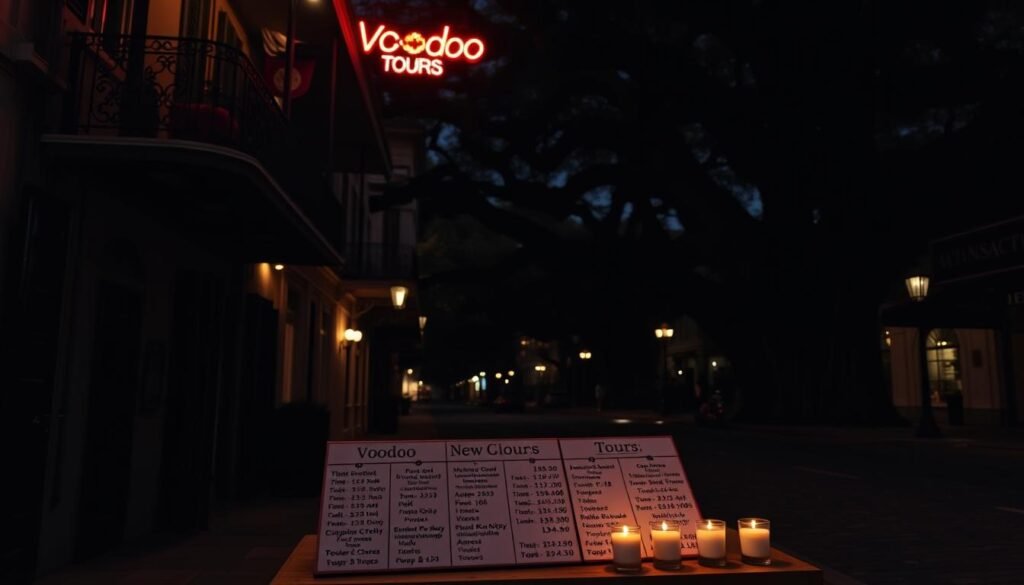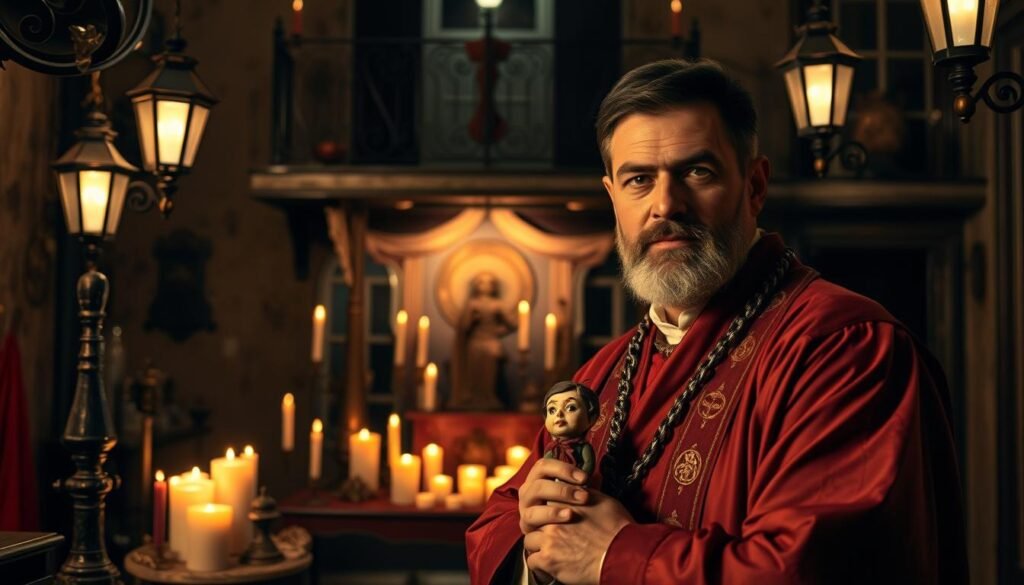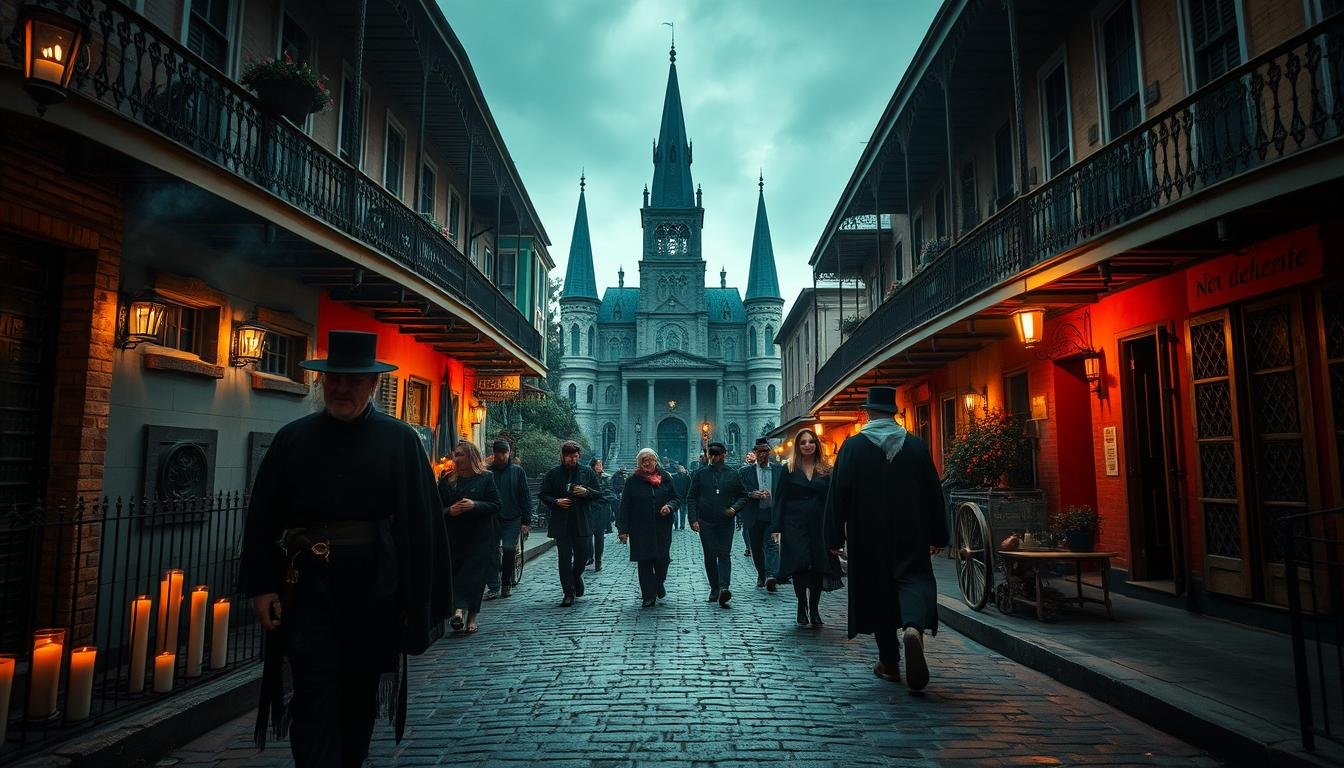I’ll show you New Orleans the way we live it—where culture and ritual mix with everyday life. Take a walk with me through Congo Square, Tremé and the French Quarter and you’ll feel the city’s pulse. This is a small-group, on-foot tour rooted in real places and real people.
Choose the morning blessing with High Priest Robi—interactive, intimate and pay-what-you-can—or the afternoon Unveiling walking tour, which digs into history across more sites. We begin under the Archway to Armstrong Park on Rampart Street and end at Voodoo Authentica after about 1.5 hours.
Expect clear talk about Code Noir, the Haitian rebellions, and the life of Marie Laveau from a local guide who keeps it respectful. You’ll cover roughly one mile, ask questions, and leave with a deeper experience of the Quarter and the heartbeat of this city.
Key Takeaways
- Small-group, on-foot experiences led by a local guide.
- Two options: morning blessing or afternoon history-focused walk.
- Starts at the Armstrong Park arch and ends at Voodoo Authentica.
- About 1.5 hours and roughly one mile—pacing for conversation.
- Stories cover Code Noir, Haitian rebellions, and Marie Laveau.
- Respectful, authentic look at how ritual and life live together in New Orleans.
Discover the spirit of New Orleans through authentic Voodoo tours
This city keeps its past close; our walk untangles the real history behind the legends. I call out Hollywood myths and show how beliefs traveled from West Africa, changed under the Code Noir, and still shape streets and shrines in the Quarter today.
We look at rituals—gris-gris, vevers, Saint John’s Eve—and explain where they fit in community life. My guide role is to connect context to what you see: music, food, and daily practice all reflect this living culture.
“Respect matters: no staged scares, just honest stories and ethical visits to modern temples like Voodoo Authentica.”
Expect a clear, grounded experience. You’ll leave knowing how the city keeps these traditions alive—and how to honor them when you explore on your own. Pair the morning practice-focused option with the afternoon history walk for the full picture.
Voodoo tours: choose your walking tour experience
Pick the walk that fits your curiosity—hands-on ritual in Congo Square or a history-rich route through the Quarter and Tremé.
Morning: Congo Square with High Priest Robi
This is an interactive morning tour that ends with a cleansing blessing led by High Priest Robi. The session is name-your-own-price and runs with a larger group of about 20–25 people.
Expect frank talk, foraging demonstrations, and guidance on starting an ethical home practice. It’s hands-on and not for the faint of heart—raw language and tough topics appear.
Afternoon: Unveiling walking tour (French Quarter & Tremé)
The afternoon Unveiling is history-focused. Our small groups (12–14) move from the Armstrong Park arch to Voodoo Authentica.
It lasts roughly 90 minutes, costs from $39, and covers Marie Laveau, the Code Noir, Haitian rebellions, and material culture—vevers, dolls, and more.
Who each option works for
If you travel with family or want a gentler pace, choose the afternoon. If you want a participatory practice and can handle blunt conversation, choose the morning.
Voodoo vs. ghost tour: what we don’t do
We separate theatrics from living practice. This is not a ghost tour company—no staged scares, just respectful stories and contextual history.
| Feature | Morning – Robi | Afternoon – Unveiling |
|---|---|---|
| Style | Interactive ceremony, hands-on | History walk, multiple stops |
| Group Size | 20–25 | 12–14 |
| Price & Time | Name-your-price; ~90 minutes | From $39; ~90 minutes |
| Best for | Practice-seekers, bold listeners | Families, cultural explorers |
What you’ll see and learn on our New Orleans Voodoo walking tour
Walk with me through landmarks where rhythm, resistance, and ritual shaped a city’s soul.
Congo Square and Tremé
We pause where enslaved Africans drummed, danced, and held memory together. I explain how the Code Noir and the Haitian rebellions fed musical forms and spiritual practice in Tremé.
Marie Laveau’s legacy and changing practice
We unpack marie laveau—records, oral history, and the myths that pop in films and books. You’ll get history, not hype, and see how her influence still marks the Quarter.
Artifacts decoded: dolls, vevers, and gris-gris
Objects on display are tools, not curios. Dolls can be prayers, vevers are sacred maps, and gris-gris serve protection. I show what each piece means and why context matters.
Modern locations: Voodoo Authentica and the museum
We end inside Voodoo Authentica and point out the New Orleans Historic Voodoo Museum. I tell you how to visit respectfully and what you’ll find at each stop.
Rituals and living traditions
From Saint John’s Eve on the bayou to Sunday ceremonies, rituals evolve but stay rooted in community. Expect clear explanations of practice, sites, and why these moments matter today.
| Stop | What you’ll learn | Why it matters |
|---|---|---|
| Congo Square / Tremé | Drumming, Code Noir, Haitian influence | Shows resilience and origins of local spiritual culture |
| French Quarter sites | Marie Laveau stories, street shrines | Separates myth from documented history |
| Voodoo Authentica & Museum | Artifacts, respectful visiting tips | Context for modern practice and preservation |
Times, distance, price, and group size at a glance
Plan for about 1.5 hours—roughly ninety minutes of walking at an easy pace. We cover about one mile through Tremé and the French Quarter, with stops for stories and questions.

Tour duration and pace
The route moves deliberately—no rush, no filler. Expect three or four short stops and comfortable walking between them.
Ticketing and pricing
The afternoon Unveiling is ticketed from $39. The morning practice session runs on a name-your-own-price basis—pay what you feel at the end.
Group sizes
Ticketed, history-focused groups stay small—about 12–14 people so our guides can answer questions and keep conversation intimate.
The morning circle is livelier—around 20–25 people—great if you want a communal blessing and a more participatory vibe.
- Start: under the Archway to Armstrong Park on Rampart Street.
- End: inside Voodoo Authentica—easy to plan around your day.
- Wear comfy shoes, bring water, and expect photo moments.
“Our guides keep the clock and the stories—so you get the full history without feeling hurried.”
Start, end, and what to bring for your French Quarter Voodoo tour
Start at the Archway to Armstrong Park on Rampart Street—easy to spot and a short walk from Congo Square.
Where we meet: Archway to Armstrong Park on Rampart Street
I’ll be waiting under the big arch; it’s central and perfect for a quick intro before we walk. This meeting spot keeps the route tidy and ties the story to place.
Where we finish: inside Voodoo Authentica
The route winds through Tremé into the French Quarter and ends inside Voodoo Authentica. You can browse respectfully and ask questions about artifacts and practice.
What to wear and bring
Plan for about one mile on flat city streets and roughly 1.5 hours total. Wear comfortable walking shoes and light layers—summer heat and humidity arrive fast.
- Bring water and a hat in warm months.
- Camera welcome—your guide will flag sacred moments where photos should wait.
- If you need accessibility info or have a stroller, tell us ahead so we can adjust the route.
- Parking and rideshare are easy along Rampart; after the tour you’re steps from food and music in the quarter.
“Ask me about respectful visiting, local music spots, or where to grab a bite—I’m here from start to finish.”
| Item | Details | Why it matters |
|---|---|---|
| Meeting point | Archway to Armstrong Park on Rampart | Clear, central, close to Congo Square |
| Finish | Voodoo Authentica (inside) | See modern practice and artifacts respectfully |
| On-foot | ~1 mile; ~1.5 hours | Easy pace with stops for stories and photos |
| Bring | Comfortable shoes, water, camera | Comfort, hydration, and good photos |
Why choose our guides for your New Orleans Voodoo history tour
You’ll meet storytellers who blend neighborhood memory with archival facts—clear, human, and local.
High Priest Robi brings lived practice to the morning circle. His voice carries ritual detail and hard truths. He answers direct questions and does not soften difficult topics.
Our afternoon guides come from established local groups and carry years of study. They shape a 90-minute history tour that links street corners to documents and oral sources.
We teach with respect. History is anchored to sources. Living practice is handled carefully. We present tradition with dignity and context—no theatrics, no cheap scares.
Small groups make it a conversation, not a lecture. Ask tough questions—our guides will answer with care and clarity. We train together, share updates, and stay connected to neighborhood life so the knowledge we offer is current.
“Our goal is accuracy and respect—history with a heartbeat, shared by people who live it.”

| What to expect | Morning leader | Afternoon guides |
|---|---|---|
| Approach | Practicing expert, direct | Storytellers, researched context |
| Group size | 20–25 | 12–14 |
| Focus | Ritual practice and lived knowledge | History, artifacts, community stories |
| Why it matters | Firsthand perspective on living tradition | Contextual, accurate history for visitors |
- Local knowledge—from temple etiquette to where to keep learning.
- Years spent listening to elders and neighbors shape how we teach.
- If you value authenticity over spectacle, our guides are your people.
Conclusion
Pair the morning blessing with the afternoon history walk to feel how practice and place connect across the French Quarter and Tremé.
I lead both the hands-on morning circle and the ticketed afternoon voodoo tour so visitors get roots and records—Congo Square, Marie Laveau, and the modern temple at Voodoo Authentica.
Start under the Archway to Armstrong Park, walk about one mile, and spend roughly 90 minutes with each option. The afternoon history tour runs from $39; the morning session is name-your-price.
This is culture-forward, not a ghost show. Expect clear history, living practice, and an experience that leaves you with real knowledge to explore the city with respect.
FAQ
What makes your New Orleans voodoo walking tour different from a ghost walk?
Our walk centers on living history and cultural practice—not cheap scares. We focus on the roots in Congo Square and Tremé, Marie Laveau’s legacy, and how rituals continue today. Expect respectful storytelling, real locations like Voodoo Authentica and the Voodoo Museum, and context that separates theatrical ghost tales from authentic tradition.
Which tour should I pick—morning with High Priest Robi or the afternoon history route?
Choose the morning for a more interactive experience that can include a blessing and rhythm in Congo Square. Pick the afternoon if you want a thorough history-focused walk through the French Quarter with stops explaining artifacts, vevers, and gris-gris bags. Both cover similar landmarks but offer different rhythms—one participatory, one archival.
How long is the tour and how far will we walk?
The typical tour runs about 1.5 hours and covers roughly one mile at an easy pace, with frequent stops for stories and questions. We keep groups moving gently—no marathon required.
What are the ticketing options and typical price?
We offer ticketed tours starting around and also name-your-price options on select departures. Check availability online—small, ticketed groups fill first, then our pay-what-you-like slots.
How large are the groups?
For ticketed departures we keep groups to about 12–14 people for an intimate vibe. Pay-what-you-like sessions can run larger—around 20–25 guests—while still maintaining a tight listening circle.
Where do tours start and end in the French Quarter?
We meet at the archway leading into Louis Armstrong Park on Rampart Street and wrap up inside Voodoo Authentica, so you get a mix of public space and a curated modern temple/shop to explore.
What should I wear and bring?
Dress for walking—comfortable shoes, light layers depending on season, and a refillable water bottle. Bring a camera and your curiosity. We recommend modest, respectful behavior at active sites and private businesses.
Are tours family-friendly? Can children attend?
Yes—many families join. We tailor language and depth for mixed groups. If you have very young children or sensitive visitors, let us know and we can advise which departure will work best.
Do guides practice the traditions they teach about?
Our guides are local storytellers and cultural stewards—many have deep ties to the community and longstanding knowledge of rituals, history, and places. They present both academic context and lived experience while keeping the tour respectful and educational.
Will we see actual artifacts or just hearsay about them?
You’ll learn about real objects—dolls, vevers, and gris-gris bags—and hear how they’re used and interpreted. We stop at museums and shops where you can view pieces up close and ask questions of curators and local vendors.
Is photography allowed during the tour?
Yes—photos are fine at public sites and most businesses, but we ask guests to be mindful and to follow any signage or staff requests, especially inside active temples or private ceremonies.
How do you handle sensitive cultural material and community traditions?
We take a respectful, educational approach—centering history, contemporary practice, and community voices. Guides explain context, avoid sensationalism, and encourage visitors to observe with humility and curiosity.
